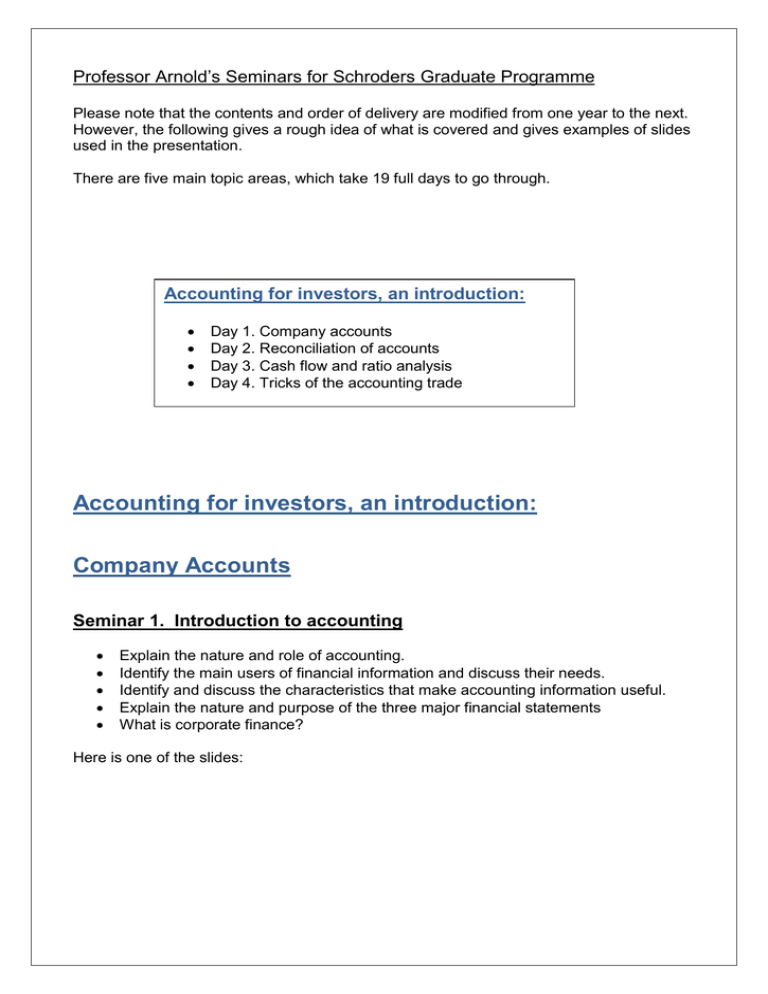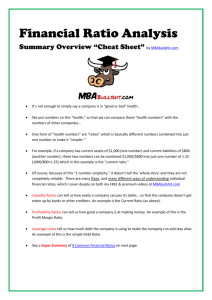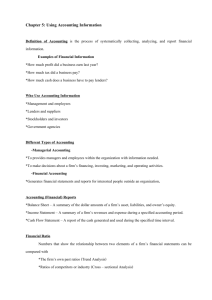Accounting for investors: an introduction
advertisement

Professor Arnold’s Seminars for Schroders Graduate Programme Please note that the contents and order of delivery are modified from one year to the next. However, the following gives a rough idea of what is covered and gives examples of slides used in the presentation. There are five main topic areas, which take 19 full days to go through. Accounting for investors, an introduction: Day 1. Company accounts Day 2. Reconciliation of accounts Day 3. Cash flow and ratio analysis Day 4. Tricks of the accounting trade Accounting for investors, an introduction: Company Accounts Seminar 1. Introduction to accounting Explain the nature and role of accounting. Identify the main users of financial information and discuss their needs. Identify and discuss the characteristics that make accounting information useful. Explain the nature and purpose of the three major financial statements What is corporate finance? Here is one of the slides: What is accounting? • The collecting, analysis and communication of financial information • For decision-making and planning, e.g. – Developing a new product – profit, cash flow forecasts – Costing or pricing a product – Changing methods of production, distribution etc. – – – – Deciding whether to invest in the company’s shares Lending money to the business Offering credit facilities to the business Contracts to purchase from the business Seminar 2. The balance sheet Describe the main categories of assets and liabilities of a company and explain the capital claim of the owners Prepare a simple balance sheet and interpret the information that it contains. Discuss the accounting conventions underpinning the balance sheet. Discuss the uses and limitations of the balance sheet for decision-making purposes. Here is one of the slides: The classification of liabilities Amounts due for settlement in the short term. Current liabilities Non-current liabilities Those that do not meet the definition of current liabilities Meeting ANY of the following: •Expected to be settled within the normal course of business’s operating cycle •Due to be settled within 12 months following the date of the balance sheet on which they appear. •Held primarily for trading purposes •There is no right to defer settlement beyond 12 months following the date of the BS on which they appear. Seminar 3. Income statement Discuss the nature and purpose of the income statement. Prepare an income statement from relevant financial information and interpret the information that it contains Discuss the main recognition and measurement issues that must be considered when preparing the income statement Explain the main accounting conventions underpinning the income statement. Here is one of the slides: Afternoon In groups prepare answers to accounting questions. Presentations and discussion. Reconciliation of Accounts Session 1. Expenses. Corporate governance. Understand the treatment of depreciation of non-current assets Explain the alternative ways of accounting for the usage of inventory Describe how to treat bad and doubtful debts Discuss the need for corporate governance rules and the principles upon which such rules should be based Explain the role and composition of the board of directors and discuss the issues and problems associated with the roles of chairman and non-executive director Here is one of the slides: Corporate governance Corporate governance means the system by which companies are managed and controlled Shareholders Board of directors Executive Non-executive Top tier of managers Seminar 2. Accounting for Limited Companies Describe the main features of the owners’ claim in a limited company. Explain accounting entries related to changes in the equity capital of a firm Discuss the nature of groups, and how they are formed Explain and interpret the contents of a set of group financial statements Here is one of the slides Jargon • Authorised and issued (or allotted) share capital: that which has been issued as well as being created • Usually ‘fully paid’ • Called-up share capital: Amount of the capital due from the shareholders where the shares are being paid in instalments or in calls • Paid-up share capital: That part that has been called and paid. Seminar 3. The annual report Describe the responsibilities of directors and auditors concerning the annual financial statements. Identify the main sources of regulation affecting the financial statements of limited companies Discuss the framework of principles for accounting. Understand the major financial statements prepared in accordance with International Financial Reporting Standards. Explain the purpose of the segmental report and the operating and financial review and describe their main features. Here is one of the slides: Is management commentary useful for investors? FT article: interview responses 4.8.10 Afternoon In groups prepare answers to accounting questions. Presentations and discussion. Cash flow and ratio analysis Seminar 1. The main features of a cash flow statement Discuss the crucial importance of cash to a business. Explain the nature of the cash flow statement and discuss how it can be helpful in identifying cash flow problems. Discuss the problem of overtrading Use the indirect method to deduce the figure for ‘the cash flow from operating activities’ Here is one of the slides: TESCO plc Seminar 2. A cash flow statement. Key investment measures and ratios from the financial pages • • • • Prepare a cash flow statement Explain company data in the Financial Times Calculate ratios and other measures from the base data Analyse a company using key measures and ratios Here is one of the slides: PERs - continued Earnings yield: Earnings per share ÷ current market price of share Earnings yield = 68p/900p = 7.56% Historical PERs: usually based on the latest annual reports and accounts, and are updated on interim figures ‘basic’ earnings, ‘FRS 3’ earnings diluted earnings per share headline, underlying, adjusted or normalised eps If shares are issued during the year so there are more at the end than at the beginning, a weighted average number of shares will be used to calculate eps Eps from ‘continuing operations’ Seminar 3. Analysing and interpreting financial statements: Profitability and efficiency Explain how ratios can be used to assess the position and performance of a business. Identify the major categories of ratios that can be used for analysis purposes. Calculate key ratios for assessing the profitability and efficiency of a business. Explain the significance of the ratios calculated. Here is one of the slides: The need for comparison Ratios may be compared with: •Are trading conditions the same? •Have similar businesses done as well or better? •Inflation can distort Past periods Similar businesses during the same period Planned performance •Competitors may have different year-ends •Different accounting policies •Often difficult to obtain the financial statements of competitors •Are they based on realistic assumptions? •Is the past a good guide? Afternoon In groups prepare answers to accounting questions. Presentations and discussion Ratio analysis and tricks of the accounting trade Seminar 1. Liquidity and financial gearing ratios. Predicting financial failure • • • • • Calculate and interpret liquidity ratios Calculate and interpret financial gearing ratios Produce trend analysis for a business Use ratios to predict financial failure Discuss the limitations of ratio analysis Here is one of the slides: M&S Key Performance Indicators Seminar 2. A few tricks o o o o o o Goodwill Fair value Revenue recognition Exceptional items Inventory valuation Depreciation Capitalisation Here is one of the slides: What was our revenue again? • Rules: recognized in the period when the substantial risks and rewards of ownership are transferred and the amount of revenue can be measured reliably. • when the order is placed? when you receive cash from the customer? when the goods are delivered to the customer? • A long-term contract to build and service a power station: – – – – Order is placed in 2008, Construction begins in 2009, First payments are received in 2010 Ongoing annual service activity is expected from 2011 Seminar 3. A few tricks more Off-balance sheet items Share options Pro-forma Discontinued operations Write-downs Foreign exchange How to avoid being taken for a ride Here is one of the slides: Stock (inventory) valuation • Should be shown on the balance sheet at cost or net realisable value, whichever is lower • Steel bought in • Half complete car • Overheads: business expenses that range over the operations as a whole and are not directly chargeable to a particular part of the work or product Afternoon Presentations Examine Schroders’ annual report and accounts. Prepare the following presentations: 1. Undertake a ratio analysis of Schroders with a focus on profitability and efficiency. 2. Undertake a ratio analysis of Schroders with a focus on liquidity and gearing. 3. Read the notes to Schroders accounts and prepare a presentation that describes fundamental accounting principles (e.g. accruals concept, revenue recognition). Illustrate these concepts with examples drawn from Schroders.






